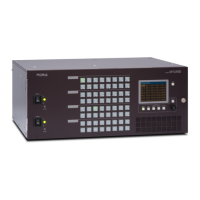35
RS-422 Transmission Settings
The Route and Switching Mode settings allow you to minimize I/O delay or to prevent data
loss or corruption during switches.
They can be set in the [Web-based Control: RS-422 Settings page].
To transmit data with minimum delay:
>> Select Direct under Route.
To guarantee transmission reliability:
>> Set Switching Mode to ON and specify Data Rate, Parity and Stop Bit.
The table below shows details on how data switches are performed within the same card or
between cards depending on the Route and Switching Mode settings.
I/O delay: Large
Asynchronous
Data loss: No
I/O delay: Large
Asynchronous
Data loss: No
I/O delay: Small
Asynchronous
Data loss: Yes
I/O delay: Large
Asynchronous
Data loss: Yes
I/O delay: Large
Synchronous
Data loss: Yes
I/O delay: Large
Synchronous
Data loss: Yes
I/O delay: The minimum delay is approx. 190 nsec (Small) when an input and output ports are on the
same card. In other cases, the delay becomes larger, from 0.8 msec (Large).
Synchronous / Asynchronous: This indicates whether data switches are always synchronizes with
audio and video switches. “Asynchronous“ means data switches may be delayed by one field (or one
frame) relative to video or audio switches.
Data loss: This indicates whether data loss can occur during switches.

